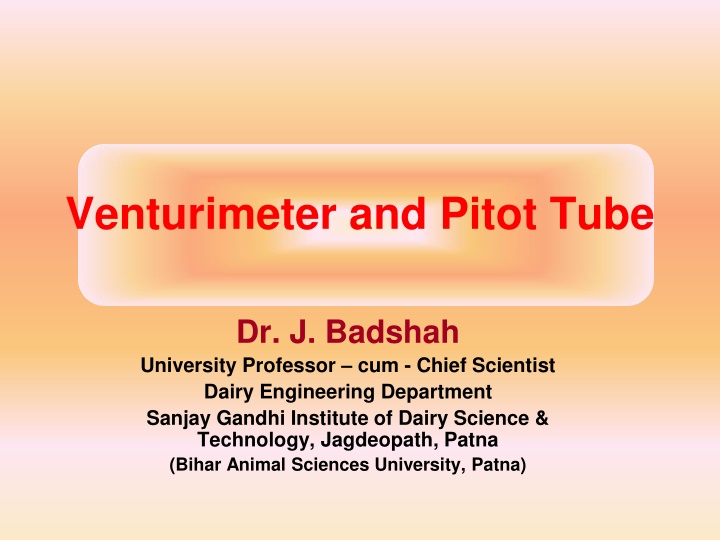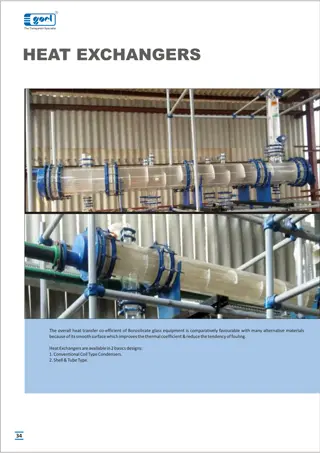Venturimeter and Pitot Tube
Venturimeter and Pitot tube are essential devices for flow measurement in various industries. Venturimeter utilizes the principle of pressure difference to determine flow rates, especially in large diameter pipes. On the other hand, the Pitot tube is commonly used for velocity and flow rate measurements. These tools play a crucial role in accurately monitoring and controlling fluid flow processes. They offer reliable performance, accuracy, and versatility, making them ideal for a wide range of applications.
Download Presentation

Please find below an Image/Link to download the presentation.
The content on the website is provided AS IS for your information and personal use only. It may not be sold, licensed, or shared on other websites without obtaining consent from the author.If you encounter any issues during the download, it is possible that the publisher has removed the file from their server.
You are allowed to download the files provided on this website for personal or commercial use, subject to the condition that they are used lawfully. All files are the property of their respective owners.
The content on the website is provided AS IS for your information and personal use only. It may not be sold, licensed, or shared on other websites without obtaining consent from the author.
E N D
Presentation Transcript
Venturimeter and Pitot Tube Dr. J. Badshah University Professor cum - Chief Scientist Dairy Engineering Department Sanjay Gandhi Institute of Dairy Science & Technology, Jagdeopath, Patna (Bihar Animal Sciences University, Patna)
Flow Measurement Introduction A flowmeter to measure linear, nonlinear, mass or volumetric flow rate of a liquid or a gas in liters per second or kilograms per second Positive-displacement flow meters Ventury meter Orifice Flow meter Rotameter Pitot Tube
Venturimeter Venturimeter is used to the measurement of flow rate. It is generally used for large diameter pipes. The venturi tube has a entrance zone, converging conical inlet, a cylindrical throat, and a diverging recovery cone. Entrance Section is a straight cylinder having length equal to 5 to 8 times the diameter of the pipe. The diameter of the tube of convergence section gradually decreases. The angle of cone = 21 2 . When liquid flows inside the venturimeter, the velocity of fluid increases and correspondingly the pressure falls. At throat, the diameter of the venturemeter cylindrical tube is minimum. Velocity is maximum and pressure is minimum. Throat diameter = 1/3 to 1/4th inlet diameter. The diameter of the tube at diverging section gradually increases. Here due to gradual divergence, the pressure is build up to the original inlet pressure. The cone angle is 5-7 . Small size venturimeter are made of brass or, bronze and large venturimeters are made of cast iron or stainless steel. The pressure difference between the upstream side of the cone and the throat is measured and provides a signal for the rate of flow.
Measurement of Flow rate in venturimeter Flow rate can be given as: Q = Cda1a2 { (a1)2- (a2)2} {2g (p1 p2)/w Where, Q = flow rate, Cd= Coefficient of discharge. a1= area at the entrance of venturi a2= area at the venturi throat p1= Pressure at entrance of venture p2= Pressure at venture throat w = g The venturi tube is suitable for clean, dirty and viscous liquid and some slurry services. Loss of head due to installation in the pipeline is small. Original pressure of the liquid can be recovered completely. Accuracy is 1% of full range 5. Not much wear and tear. Characteristics are well established and it is in use since years. Can be used for large flow rates and large diameter pipes. Space requirements are more and it is Expensive in installation.
Pitot Tube for velocity and flow Measurement
Pitot Tube Pitot tube is used to measure flow velocity. Outer body of pilot tube consist of ports at point A, for sensing the static pressure of fluid. At point B fluid velocity become zero and inner tube is for sensing the stagnation pressure. The outlet C & D is connected to U-tube manometer for measuring the pressure difference between the points A and B. Pitot tube The flow velocity is given by the following equation: V = (2 g h)























